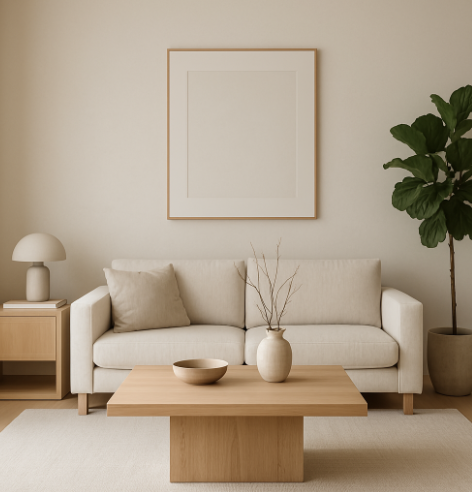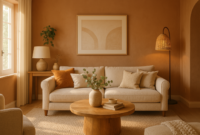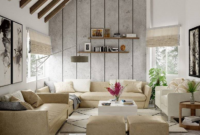Minimalist Living Room
In a world that feels increasingly loud, fast, and cluttered, the minimalist living room offers a welcome pause—a space that breathes, soothes, and invites clarity. Minimalism, as both a design philosophy and a lifestyle, is rooted in the principle of “less is more.” Nowhere is this idea more beautifully expressed than in the living room, the heart of any home. By thoughtfully paring down and prioritizing quality over quantity, minimalist living rooms bring together form and function in a tranquil balance.
The Essence of Minimalism
Minimalism is more than just an aesthetic. It is a way of life that challenges excess, celebrates simplicity, and embraces the idea that every item in a space should serve a purpose—whether practical, emotional, or visual. In a minimalist living room, each object has meaning and intention. Clutter is eliminated to make way for calm, and visual noise is replaced with peaceful openness.
The philosophy is deeply rooted in Japanese Zen traditions, which emphasize balance, natural elements, and thoughtful restraint. Scandinavian design also plays a major role, with its love of natural light, clean lines, and functionality.
Foundational Elements of a Minimalist Living Room
Let’s break down what makes a minimalist living room not just beautiful, but also deeply livable.
1. Color Palette
The minimalist color palette is typically soft and muted—think whites, creams, grays, taupe, and earth tones. These colors don’t compete for attention; instead, they create a harmonious backdrop that soothes the senses. You might see pops of color, but they’re subtle—perhaps a pale sage green throw pillow or a single dusty rose vase.
The power of this muted palette lies in its flexibility. It complements a variety of textures and materials while maximizing natural light. The result is a space that feels both expansive and intimate.
2. Furniture with Purpose
Minimalist furniture is defined by clean lines, simple shapes, and unobtrusive elegance. Each piece is chosen for its functionality and form, often leaning toward modern or mid-century modern styles. Overstuffed sectionals and ornate details are swapped for low-profile sofas, sleek wooden coffee tables, and open shelving.
In a minimalist living room, the furniture often features legs or slim bases, allowing the space to feel lighter and airier. Think of a floating media console, a pair of elegant armchairs, or a simple platform sofa with just a few plush cushions.
3. Emphasis on Space and Light
One of the most defining features of a minimalist living room is open space. The design allows the room to breathe by carefully spacing furniture, minimizing visual clutter, and maximizing natural light. Large windows are often left uncovered or dressed in sheer curtains that let the sunlight in while softening its intensity.
Mirrors may be used to reflect light and create a sense of openness, and the layout is always intentional—focused on flow, balance, and ease of movement.
4. Decluttered Surfaces
Flat surfaces—coffee tables, shelves, sideboards—are largely kept free of unnecessary decor. Instead of an array of knick-knacks, you might find a single ceramic vase or a stack of design books. This intentional restraint gives the room a sense of order and calm.
Storage is key here. Minimalist living rooms often feature hidden storage solutions like built-in cabinets or multifunctional furniture that help keep everyday items tucked away but accessible.
5. Textures and Natural Materials
With fewer objects in the room, texture plays a big role in adding depth and interest. Linen cushions, wool throws, smooth stone, aged wood, and matte ceramics create a rich tactile experience without visual overload.
Natural materials such as oak, cotton, bamboo, and leather are favorites in minimalist interiors. These elements not only ground the space but also bring warmth and an organic, earthy touch to balance the cool simplicity of the color scheme.
6. Curated Decor
In a minimalist living room, less does not mean bare. Art and decor are carefully curated to make a quiet statement. A large, abstract painting on one wall, a monochrome photography piece, or even a single sculptural object can serve as a focal point.
Plants also play a role here—not a jungle, but perhaps one or two well-placed green companions like a fiddle-leaf fig or a trailing pothos. They bring life, color, and a sense of well-being to the room.
Why Choose a Minimalist Living Room?
Minimalism isn’t just about appearances—it’s about how a space makes you feel and function. Here are some compelling reasons to embrace this lifestyle shift:
1. Mental Clarity
Clutter in the home can lead to stress and anxiety. A minimalist living room creates an environment that promotes mental clarity and emotional calm. Fewer distractions mean you can focus, unwind, and truly enjoy your space.
2. Easier Maintenance
With fewer items and more open space, minimalist living rooms are easier to clean and maintain. Dusting, vacuuming, and tidying up become much simpler tasks, freeing up your time for the things that really matter.
3. Financial Benefits
Minimalism encourages thoughtful purchasing and investing in quality pieces that last. Over time, this approach can actually save money by reducing impulse buys and prioritizing durability over trends.

4. Environmental Impact
Choosing fewer, more sustainable pieces and avoiding fast furniture contributes to a more eco-friendly lifestyle. Minimalism often aligns with values of sustainability and conscious consumption.
5. Enhanced Aesthetics
Minimalist spaces are often timeless. Their simplicity allows the beauty of form, light, and material to shine. They don’t chase trends but instead rely on classic design principles that age gracefully.
Common Misconceptions About Minimalist Living Rooms
There are some myths about minimalism that can make it seem intimidating or unapproachable. Let’s debunk a few:
-
Myth 1: Minimalism is cold or sterile.
In reality, when executed well, minimalism is warm, cozy, and inviting. It’s about balance and harmony, not austerity. -
Myth 2: You can’t have personality in a minimalist room.
Quite the opposite. Minimalism allows personal items to shine. A beloved artwork, a handmade ceramic bowl, or a meaningful heirloom can take center stage. -
Myth 3: Minimalist design is only for small spaces.
While it’s true that minimalist principles can make small spaces feel larger, they’re just as effective in spacious homes, creating a sense of openness and calm.
Creating Your Own Minimalist Living Room: A Step-by-Step Guide
If you’re ready to start designing your own minimalist living room, here’s a roadmap to get you started:
Step 1: Declutter Ruthlessly
Start by removing anything that doesn’t serve a purpose or bring joy. Be honest about what you use and what’s just taking up space. Clear surfaces, drawers, and corners.
Step 2: Define Your Color Palette
Choose a neutral base palette and stick to it. Whites, soft grays, beiges, and natural woods form a timeless foundation. Accent colors can be added sparingly for personality.
Step 3: Select Core Furniture
Pick high-quality furniture pieces that you love and that fit the space. Keep lines clean and forms simple. Ensure there’s enough space between items to allow for visual breathing room.
Step 4: Add Layered Textures
Incorporate softness and warmth through materials—rugs, textiles, and upholstery. Choose pieces that feel good as well as look good.
Step 5: Curate Accessories Thoughtfully
Limit decor items to a few cherished or striking pieces. Think sculptural shapes, books, bowls, and art. Let each object speak on its own.
Step 6: Embrace Negative Space
Let emptiness be part of the design. Don’t feel the need to fill every corner. The “white space” is what gives a minimalist room its elegant calm.
Minimalism for Families and Everyday Life
A common concern is whether minimalist design works for families or people with busy lives. The answer is yes—with a few adjustments. Minimalism doesn’t mean living with nothing; it means living with enough.
In a family home, minimalism can be achieved by incorporating smart storage, creating kid-friendly zones, and emphasizing function. Baskets, ottomans with compartments, and hidden storage furniture are all helpful tools for keeping things both tidy and accessible.
Minimalism is also adaptable. It doesn’t have to be extreme. You might choose to have a minimalist living room while embracing more eclectic styles in other parts of the home. It’s about what works for your life.
Conclusion
The minimalist living room is more than a trend—it’s a timeless reflection of intentional living. It offers a sanctuary from the chaos of modern life and a return to what matters most: connection, comfort, and clarity.
Whether you’re starting from scratch or refining your existing space, embracing minimalism in your living room invites beauty, simplicity, and peace into your everyday environment. And that, perhaps, is the greatest luxury of all.


